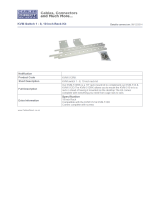
16
6. KVM Operation
(
continued
)
6.4.10 Local Console Hotkey Commands
(
continued
)
• TheStation Number precedes the Port Number.
• StationandPortnumbersarealways2digits,so1-9becomes01-09.
Forexample,acomputerattachedtoPort7ofStation15hasaPortID
of15-07.
Selecting the Active Port
You can directly access a port by doing the following:
1. InvokeHotkeyMode.
2. EnterthePortID.ThePortIDnumbersappearonthecommandline
as they are entered. To correct a mistake, use [Backspace] to erase the
wrong number.
3. Pressthe[Enter]key;theKVMswitchestothedesignatedcomputer
andyouautomaticallyexitHotkeyMode.
Auto Scan Mode
Wheninvoked,Auto Scan Mode monitors the connected computers
automatically at regular intervals so that you don’t have to manually
switchbetweenthem.WheninAutoScanMode,theKVMswitch
monitors the connected computers per the Scan Select and Scan Duration
settings in the F3 Set pageofthelocalconsoleOSD(seepage28for
details). To invoke Auto Scan Mode, follow these steps:
1. InvokeHotkeyMode.
2. Keyin[A] and hit the [Enter] key. (You can also key in [Q] instead of
[A].) You automatically exit Hotkey Mode and enter Auto Scan Mode.
3. Auto Scan Mode can be paused at any time by pressing the [P] key or
left-clickingthemouse.Toresumescanning,pressanykeyorleft-click
the mouse.
4. To exit Auto Scan Mode, press the [Esc] key or [Spacebar] key.
Note: While Auto Scan Mode is in effect, ordinary keyboard and mouse
functions are suspended; only Auto Scan Mode compliant keystrokes
and mouse clicks can be input. You must exit Auto Scan Mode in order to
regain normal control of the console.
Skip Mode
Skip Mode allows connected computers to be accessed using the [ ], [ ],
[ ] and [ ] keys on the keyboard. This manual version of Auto Scan
Mode lets you dwell on a particular port for as long as you like. To invoke
Skip Mode, follow these steps:.
1. InvokeHotkeyMode.
2. Press the [ ], [ ], [ ] or [ ] key.
3. Afterpressingoneofthearrowkeys,youautomaticallyexitHotkey
Mode and enter Skip Mode.WheninSkip Mode, you can switch ports
as follows:
• The[ ] key skips from the current port to the first accessible port
prior to it.
• The[ ] key skips from the current port to the first accessible port
after it.
• The[ ] key skips from the current port to the last accessible port of
the previous station.
• The[ ] key skips from the current port to the first accessible port of
the next station.
4. To exit Skip Mode, press the [Esc] key.
Note:
1. While Skip Mode is in effect, you can keep on skipping through ports
until you exit.
2. During Skip Mode, ordinary keyboard and mouse functions are
suspended—only Skip Mode compliant keystrokes can be input. You
must exit Skip Mode in order to regain normal control of the console.
Hotkey Beeper Control
To toggle the Beeper on and off, key in the following hotkey combination:
1. Invoke Hotkey Mode.
2. Keyin[B]. After you press [B], the Beeper toggles On or Off. The
command line displays Beeper On or Beeper Offforonesecond;then
the message disappears and you automatically exit Hotkey Mode.
Computer Keyboard/Mouse Reset
If the keyboard or mouse ceases to function for a particular port, you can
perform a keyboard/mouse reset via the hotkey command below. This
performsthesamefunctionasunplugging/re-pluggingthekeyboardand
mouse on the connected computer. To perform a keyboard/mouse reset, do
the following:
1. Invoke Hotkey Mode.
2. Press the [F5] key. After pressing the [F5] key, you exit Hotkey Mode
andtheKVMswitchperformsakeyboard/mouseresetforthecurrently
selected computer. (This may take a few seconds to take affect.)
Hotkey Mode Invocation Sequence
The hotkey sequence to invoke Hotkey Mode can be toggled via hotkey
commandaswellasthelocalconsoleOSD.(Seepage28forchanging
the Hotkey ModeinvocationsequenceviaOSD.)Totoggletheinvocation
sequence between [Num Lock, Minus] and [Ctrl, F12], do the following:
1. Invoke Hotkey Mode.
2. Press the [H] key. After pressing the [H] key, the hotkey mode
invocationsequenceischangedandthetextHOTKEYHASBEEN
CHANGEDbrieyappearsonthemonitor.Hotkey Mode is then exited
andyouregainnormaloperationoftheKVMswitch.
OSD Invocation Sequence
ThehotkeysequencetoinvoketheOSDcanbetoggledviahotkeycommand
aswellasthelocalconsoleOSD.(Seepage28forchangingthissequence
viatheOSD.)ThishotkeysetstheinvocationsequenceforboththeLocal
Console OSD and the Remote OSD. To toggle the invocation sequence
between [Scroll Lock, Scroll Lock] and [Ctrl, Ctrl], do the following:
1. Invoke Hotkey Mode.
2. Press the [T] key. After pressing the [T]key,thelocalconsoleOSD
invocationsequenceischangedandthetextHOTKEYHASBEEN
CHANGEDbrieyappearsonthemonitor.Hotkey Mode is then exited
andyouregainnormaloperationoftheKVMswitch.
Port OS Control
In addition to choosing the operating system for a connected port via the
localconsoleOSD(seepage29fordetails),administratorscansetthe
port operating system via hotkey command. To change a port’s operating
system via hotkey, do the following:
1. Invoke Hotkey Mode.
2. Keyin[Function], where [Function] represents one of the following:
a) [F1]–SetstheOperatingSystemtoWindows.
b) [F2]–SetstheOperatingSystemtoMac.
c) [F3] – Sets the Operating System to Sun.
After pressing one of these keys, the operating system will be changed for
the selected port and you will exit Hotkey Mode.
Restore Default Values
ThisAdministrator-ONLYhotkeyrestorestheKVMswitchtoitsdefault
values.(Seepage29fordetailsonrestoringtheKVMdefaultvaluesvia
OSD.)Torestorethedefaultvaluesviahotkey,dothefollowing:
1. Invoke Hotkey Mode.
2. Press the [R] key.
3. Hitthe[Enter] key. After hitting the [Enter] key, the text RESET TO
DEFAULTSETTINGisbrieydisplayed,andthenHotkey Mode is
exited.
201009236 93-2985.indd 16 11/18/2010 4:21:37 PM





















